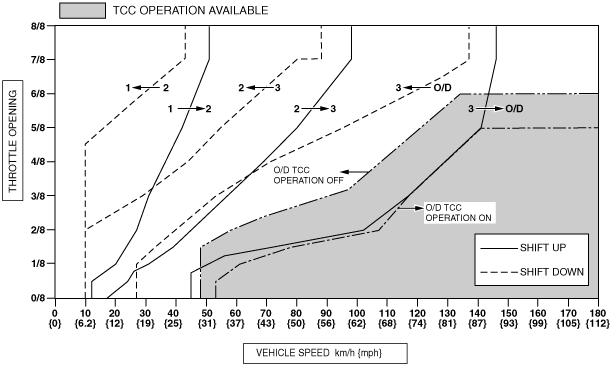 |
ROAD TEST
id051700802200
Road Test Preparation
1. Inspect the engine coolant levels.
2. Inspect the engine oil levels.
3. Inspect the ATF levels. (See AUTOMATIC TRANSAXLE FLUID (ATF) INSPECTION.)
4. Inspect the idle speed and ignition timing in P position.
5. Bring up the engine and transaxle to normal operating temperature.
Shift Diagram
D range (normal mode)
am2zzw00001096
|
D Range Test
1. Perform road test preparation. (See Road Test Preparation.)
2. Shift the selector lever to D range.
3. Perform the road test in D range (Normal).
4. Perform the road test in D range (HOLD).
Shift point table
|
Range/Mode |
Throttle condition |
Shift |
Vehicle speed (km/h {mph}) |
Turbine speed (rpm) |
|
|---|---|---|---|---|---|
|
D
|
NORMAL
|
WOT
|
D1→ D2
|
50—56 {31—34}
|
5,500—6,150
|
|
D2→ D3
|
96—104 {60—64}
|
5,850—6,300
|
|||
|
D3→ D4
|
143—153 {89—94}
|
5,600—5,950
|
|||
|
Half throttle
|
D1→ D2
|
33—40 {21—24}
|
3,550—4,450
|
||
|
D2→ D3
|
58—75 {36—46}
|
3,500—4,600
|
|||
|
D3→ D4
|
117—141 {73—87}
|
4,600—5,500
|
|||
|
TCC ON (D4)
|
117—141 {73—87}
|
3,200—3,800
|
|||
|
CTP
|
D4→ D3
|
21—27 {14—16}
|
600—700
|
||
|
D3→ D2
|
7—13 {5—8}
|
300—500
|
|||
|
D2→ D1
|
7—13 {5—8}
|
450—750
|
|||
|
Kickdown (WOT)
|
D4→ D3
|
132—142 {82—88}
|
3,600—3,850
|
||
|
D3→ D2
|
84—92 {53—57}
|
3,300—3,550
|
|||
|
D2→ D1
|
40—46 {25—28}
|
2,450—2,750
|
|||
|
POWER
|
WOT
|
D1→ D2
|
50—56 {31—34}
|
5,500—6,150
|
|
|
D2→ D3
|
96—104 {60—64}
|
5,850—6,300
|
|||
|
D3→ D4
|
143—153 {89—94}
|
5,600—5,950
|
|||
|
Half throttle
|
D1→ D2
|
36—45 {23—27}
|
3,950—4,950
|
||
|
D2→ D3
|
72—89 {45—55}
|
4,350—5,400
|
|||
|
D3→ D4
|
121—141 {76—87}
|
4,750—5,500
|
|||
|
CTP
|
D4→ D3
|
25—31 {16—19}
|
700—800
|
||
|
D3→ D2
|
7—13 {5—8}
|
300—500
|
|||
|
D2→ D1
|
7—13 {5—8}
|
450—750
|
|||
|
Kickdown (WOT)
|
D4→ D3
|
132—142 {82—88}
|
3,600—3,850
|
||
|
D3→ D2
|
84—92 {53—57}
|
3,300—3,550
|
|||
|
D2→ D1
|
40—46 {25—28}
|
2,450—2,750
|
|||
|
HOLD
|
ALL round
|
D1→ D2
|
0—3 {0—1}
|
0—300
|
|
|
D2→ D3
|
15—25 {10—15}
|
950—1,500
|
|||
|
D4→ D3
|
143—149 {89—92}
|
3,900—4,000
|
|||
|
D3→ D2
|
7—13 {5—8}
|
300—500
|
|||
|
D4→ D3
|
0—3 {0—1}
|
0—150
|
|||
S Range Test
1. Perform road test preparation. (See Road Test Preparation.)
2. Shift the selector lever to S range.
3. Perform the road test in S range (Normal).
4. Perform the road test in S range (HOLD).
Shift point table
|
Range/ Mode |
Throttle condition |
Shift |
Vehicle speed (km/h {mph}) |
Turbine speed (rpm) |
|
|---|---|---|---|---|---|
|
S
|
NORMAL
|
WOT
|
S1→ S2
|
50—56 {31—34}
|
5,500—6,150
|
|
S2→ S3
|
96—104 {60—64}
|
5,850—6,300
|
|||
|
Half throttle
|
S1→ S2
|
36—45 {23—27}
|
3,950—4,950
|
||
|
S2→ S3
|
72—89 {45—55}
|
4,350—5,400
|
|||
|
CTP
|
S4→ S3
|
143—149 {89—92}
|
3,900—4,000
|
||
|
S3→ S2
|
7—13 {5—8}
|
300—500
|
|||
|
S2→ S1
|
7—13 {5—8}
|
450—750
|
|||
|
Kickdown (WOT)
|
S3→ S2
|
84—92 {53—57}
|
3,300—3,550
|
||
|
S2→ S1
|
40—46 {25—28}
|
2,450—2,750
|
|||
|
HOLD
|
ALL round
|
S4→ S3
|
143—149 {89—92}
|
3,900—4,000
|
|
|
S3→ S2
|
95—101 {59—62}
|
3,750—3,900
|
|||
L Range Test
1. Perform road test preparation. (See Road Test Preparation.)
2. Shift the selector lever to L range.
3. Perform the road test in L range (Normal).
4. Perform the road test in L range (HOLD).
Shift point table
|
Range/Mode |
Throttle condition |
Shift |
Vehicle speed (km/h {mph}) |
Turbine speed (rpm) |
|
|---|---|---|---|---|---|
|
L
|
NORMAL
|
WOT
|
L1→ L2
|
50—56 {31—34}
|
5,500—6,150
|
|
Half throttle
|
L1→ L2
|
36—45 {23—27}
|
3,950—4,950
|
||
|
CTP
|
L4→ L3
|
143—149 {89—92}
|
3,900—4,000
|
||
|
L3→ L2
|
95—101 {59—62}
|
3,750—3,900
|
|||
|
L2→ L1
|
7—13 {5—8}
|
450—750
|
|||
|
Kickdown (WOT)
|
L2→ L1
|
40—46 {25—28}
|
2,450—2,750
|
||
|
HOLD
|
ALL round
|
L4→ L3
|
143—149 {89—92}
|
3,900—4,000
|
|
|
L3→ L2
|
95—101 {59—62}
|
3,750—3,900
|
|||
|
L2→ L1
|
40—46 {25—28}
|
2,450—2,750
|
|||
P Position Test
1. Shift into P position on a gentle slope. Release the brake and verify that the vehicle does not roll.